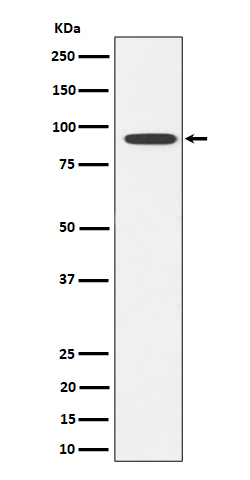
| WB | 咨询技术 | Human,Mouse,Rat |
| IF | 咨询技术 | Human,Mouse,Rat |
| IHC | 咨询技术 | Human,Mouse,Rat |
| ICC | 技术咨询 | Human,Mouse,Rat |
| FCM | 咨询技术 | Human,Mouse,Rat |
| Elisa | 咨询技术 | Human,Mouse,Rat |
| Aliases | Glycine transporter; GlyT2; NET1; SC6AC5; Slc6a5; Slc6a9;;GlyT2 |
| WB Predicted band size | 87 kDa |
| Host/Isotype | Rabbit IgG |
| Antibody Type | Primary antibody |
| Storage | Store at 4°C short term. Aliquot and store at -20°C long term. Avoid freeze/thaw cycles. |
| Species Reactivity | Human,Mouse,Rat |
| Immunogen | A synthesized peptide derived from human GlyT2 |
| Formulation | Purified antibody in PBS with 0.05% sodium azide,0.05% BSA and 50% glycerol. |
+ +
以下是关于GlyT2抗体的3篇参考文献,涵盖不同研究方向和摘要要点:
---
1. **文献名称**:*Glycine transporter GlyT2 is essential for the regulation of inhibitory synaptic transmission in the respiratory rhythm-generating network*
**作者**:Gomeza, J. et al.
**摘要**:该研究利用GlyT2基因敲除小鼠模型,结合GlyT2特异性抗体进行蛋白表达检测,发现GlyT2缺失导致呼吸节律异常,证实其在抑制性突触传递中的关键作用。
2. **文献名称**:*Structure and inhibition of the glycine transporter GlyT2*
**作者**:Drew, D. et al.
**摘要**:通过冷冻电镜解析GlyT2的分子结构,并开发选择性抗体用于蛋白纯化与功能验证,为设计靶向GlyT2的神经调控药物提供结构基础。
3. **文献名称**:*GlyT2+ neurons in the caudal spinal trigeminal nucleus contribute to neuropathic pain*
**作者**:Morita, K. et al.
**摘要**:使用GlyT2抗体标记小鼠三叉神经尾侧核神经元,揭示其在神经病理性疼痛中的作用,抑制GlyT2活性可缓解痛觉超敏。
---
这些文献分别从**基因功能**、**结构解析**及**疾病机制**角度展示了GlyT2抗体的应用。如需扩展至自身免疫研究,可补充:
4. **文献名称**:*Autoantibodies to glycine receptors and GlyT2 in autoimmune neurological disease*
**作者**:Vandenberg, R.J. et al.
**摘要**:报道GlyT2自身抗体在罕见神经系统疾病中的发现,提示其作为生物标志物或治疗靶点的潜力。
The glycine transporter 2 (GlyT2), encoded by the *SLC6A5* gene, is a sodium- and chloride-dependent neurotransmitter transporter primarily expressed in presynaptic terminals of inhibitory glycinergic neurons in the central nervous system. It plays a critical role in regulating synaptic glycine levels by mediating its reuptake, thereby terminating glycinergic signaling and maintaining neurotransmitter homeostasis. GlyT2 is essential for normal motor coordination, pain processing, and respiratory rhythms, with dysfunction linked to neurological disorders such as hyperekplexia (startle disease), chronic pain syndromes, and potentially neuropsychiatric conditions.
GlyT2-specific antibodies are vital tools for studying the distribution, expression, and functional dynamics of this transporter in both physiological and pathological contexts. These antibodies enable the visualization of GlyT2 in brain and spinal cord tissues via immunohistochemistry, Western blotting, or immunofluorescence, aiding research into glycinergic circuit organization. Additionally, they are used to investigate GlyT2 trafficking, post-translational modifications, and interactions with therapeutic agents, including inhibitors explored for analgesic applications. Recent studies also utilize GlyT2 antibodies to validate animal models of glycinergic dysfunction and assess therapeutic interventions targeting glycinergic transmission. Their specificity and reliability remain crucial for advancing understanding of GlyT2's role in health and disease.
×